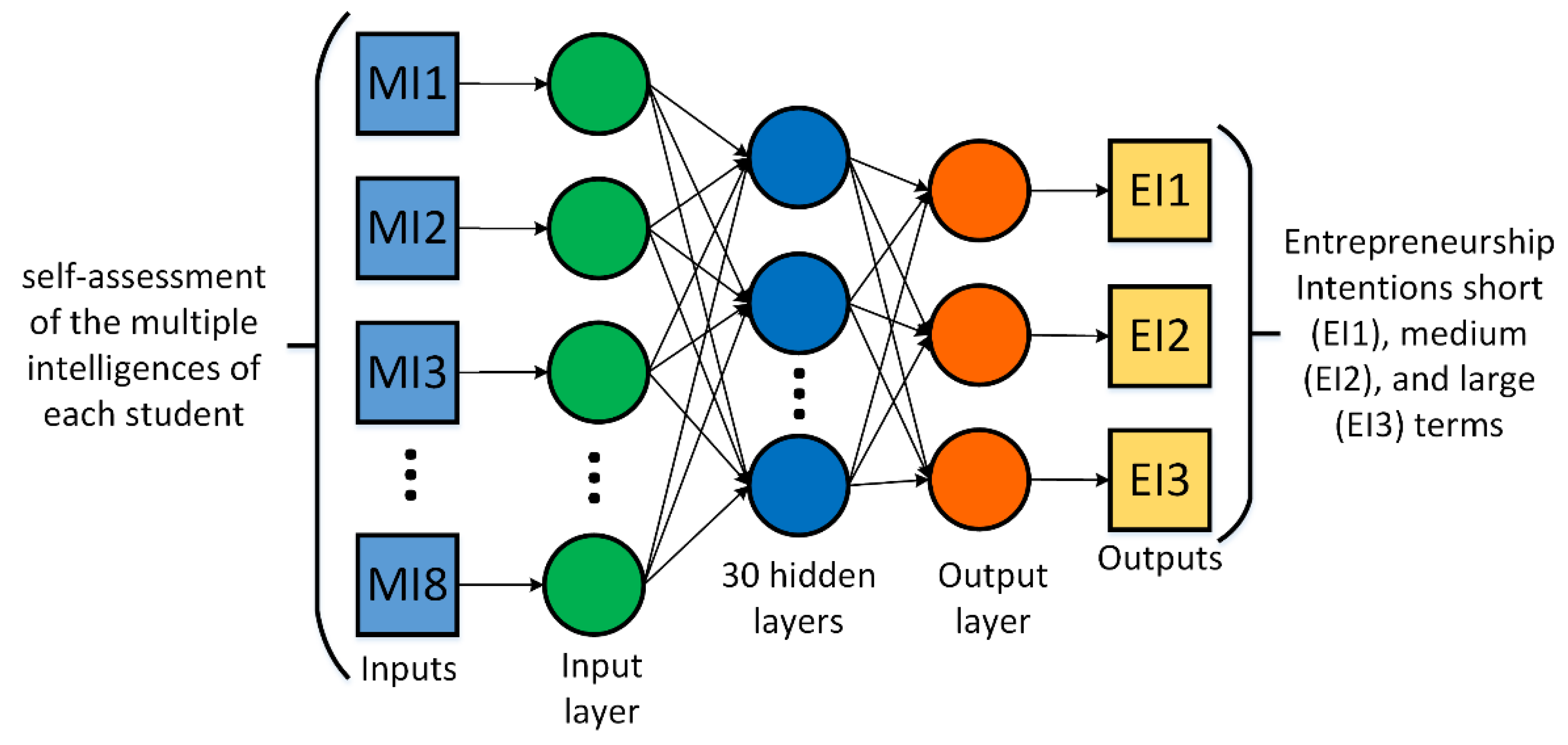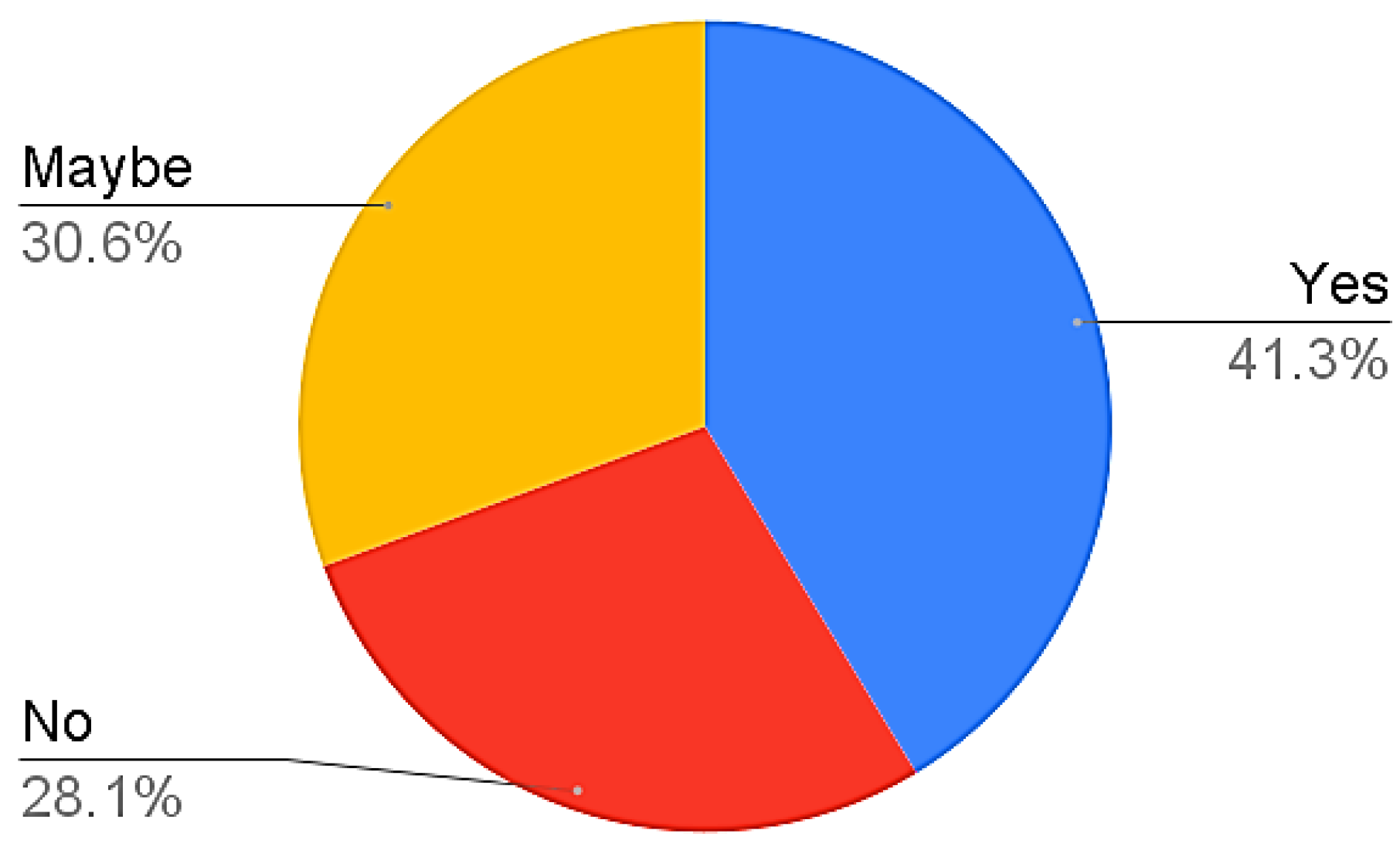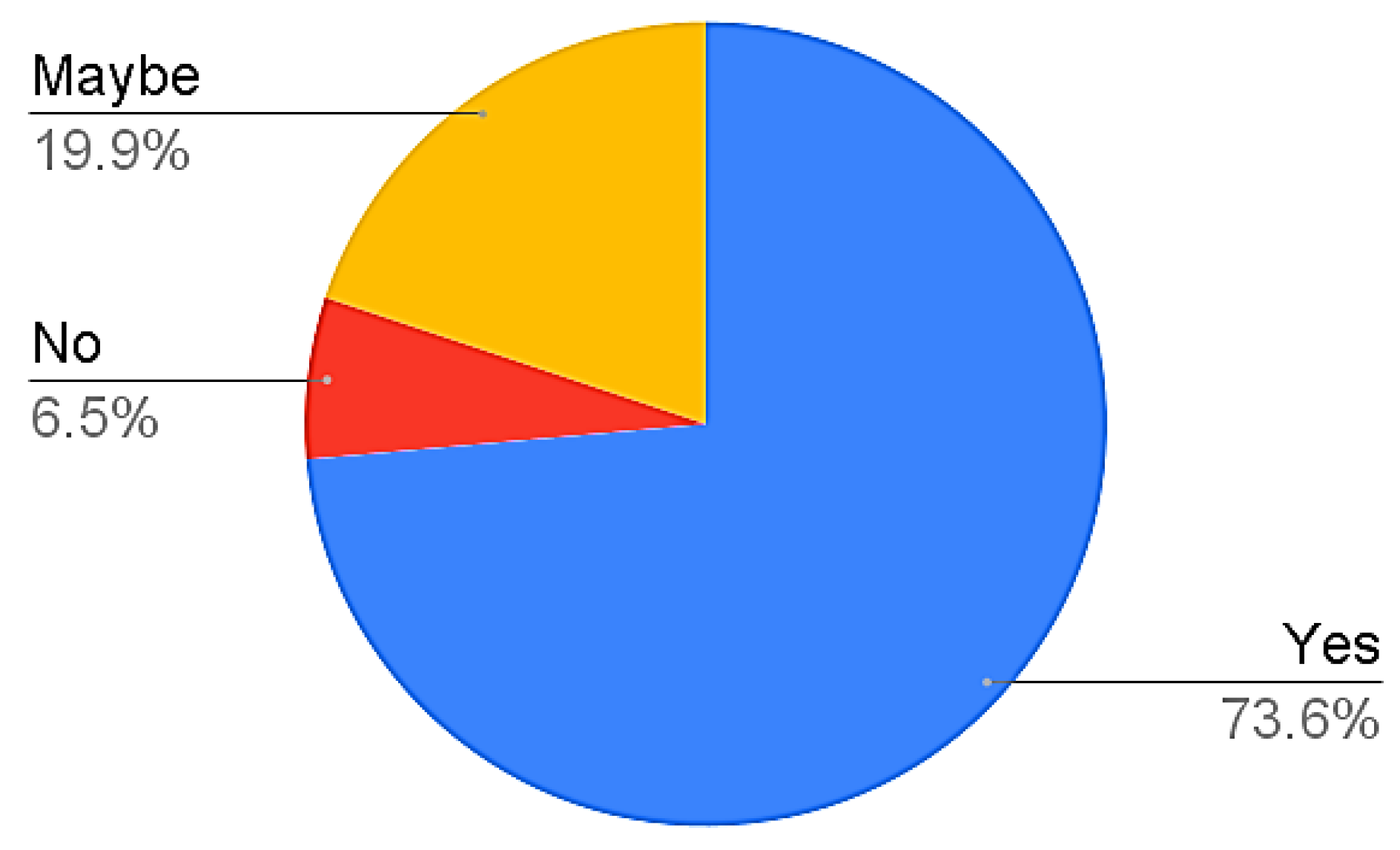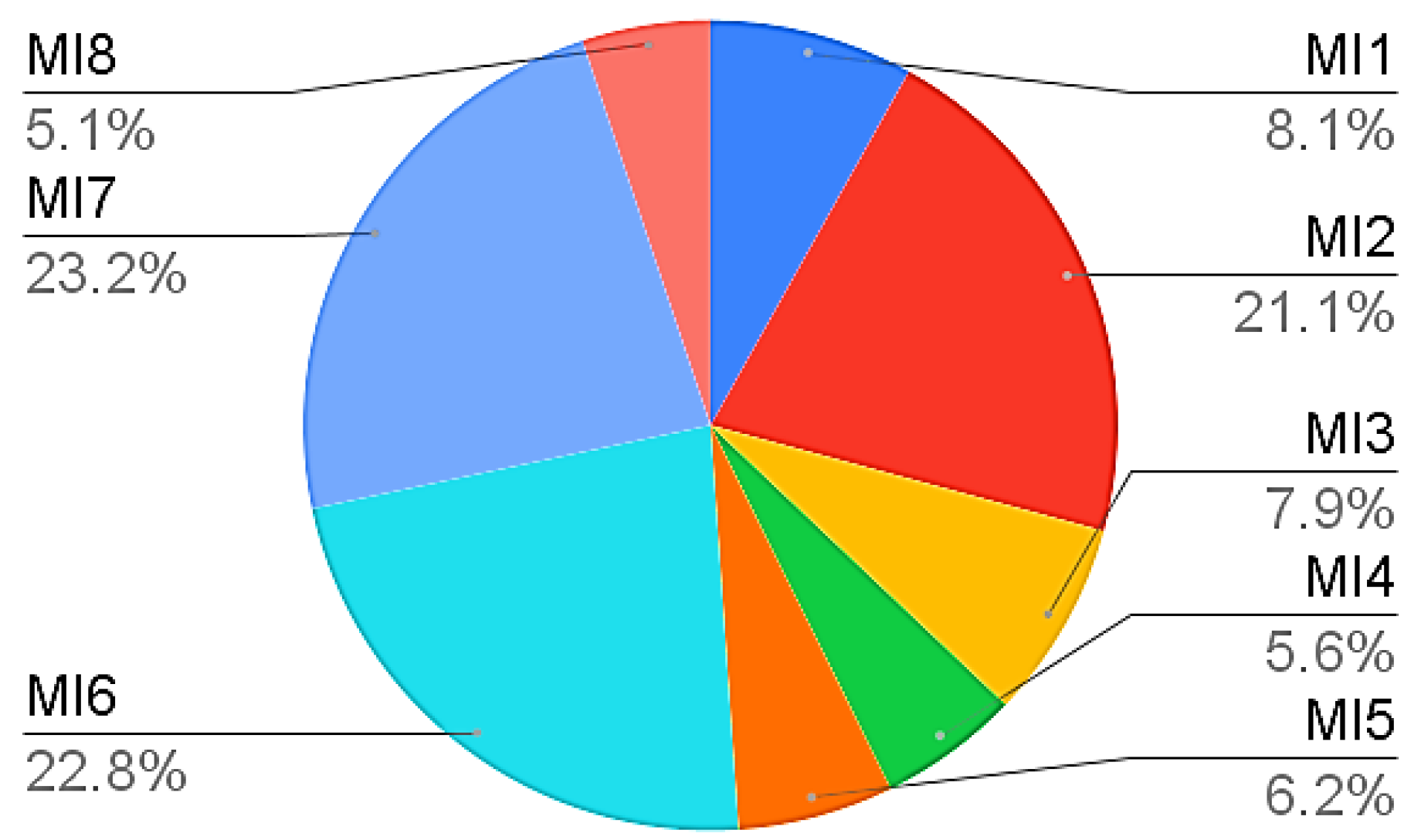Entrepreneurship Intentions Analysis of Mexican University Students Using an Artificial Neural Network to Promote Sustainable Businesses: An Interdisciplinary Perspective
Abstract
:1. Introduction
2. Multiple Intelligences and Their Relationship with Entrepreneurship
2.1. Multiple Intelligences Theory
- ✓
- It motivates the person to carry out entrepreneurial activities outside a strict teaching framework; that is, their multiple intelligences are used to catalyze the motivation of the sustainable entrepreneurship process.
- ✓
- Learning can be personalized related to sustainability and entrepreneurship based on the particular perceptions of students.
- ✓
- It facilitates people’s attention about topics, terms, and techniques of general and specific use in the field of entrepreneurship and sustainability.
- ✓
- It offers more complete and real learning concerning what sustainability and entrepreneurship mean in the personal context of the student.
- ✓
- It is possible to develop many skills and abilities that are related to the success of a sustainable entrepreneurial project.
- ✓
- It encourages unlimited creativity and invites innovation concerning sustainable entrepreneurial projects—for example, the invention of a product, process, or service with a real social impact.
2.2. Background of Entrepreneurship Patterns
3. Overall Results and Determination of Entrepreneurship Intention
4. Entrepreneurial Sustainability Activity Findings
4.1. Relation of Multiple Intelligences to Entrepreneurship Intentions
4.2. Pearson’s Correlation Coefficient Results
4.3. Performance Metrics of the ANN
4.4. Findings Analysis
- Three multiple intelligences always best represented entrepreneurship intention regardless of the temporal term. In particular, Linguistic–Verbal Intelligence (MI2), Intrapersonal Intelligence (MI6), and Interpersonal Intelligence (MI7) always showed the greatest impact on entrepreneurship intent. However, it is important to mention that Intrapersonal Intelligence (MI6) and Interpersonal Intelligence (MI7) increased their impact on the intention of long-term entrepreneurship, e.g., for the particular case of Interpersonal Intelligence (MI7), with 19.8% for short term and 25.8% for long term, whereas Linguistic–Verbal Intelligence (MI2) remained almost constant in all terms.
- Logical–Mathematical Intelligence (MI1) decreased its impact on entrepreneurship intention as the term became longer, e.g., 15.5% for short-term entrepreneurship intention, 8.1% for medium-term, and 4.1% for long-term.
- Visual–Spatial Intelligence (MI3) maintained an almost constant impact on the intention of entrepreneurship for the short, medium, and long term (approximately 8%). Similarly, Musical Intelligence (MI4) was approximately 5.6%.
- This is perhaps the finding that could generate the most surprise. The intention to undertake sustainable projects in the short, medium, and long term did not have a significant relationship with Naturalistic Intelligence (MI8). The above seems like a contradiction, i.e., how can it be that the intention to undertake a sustainable project does not have a high relationship with said intelligence? In this case, the results are not conclusive regarding the absence of this type of intelligence. Rather, the results show that a low level of this type of intelligence is required to carry out sustainable entrepreneurial projects. In the same sense, the results show that, with a low level regarding Naturalistic Intelligence (MI8) but a high level regarding Linguistic–Verbal Intelligence (MI2), Intrapersonal Intelligence (MI6), and Interpersonal Intelligence (MI7), it is possible to start a sustainable entrepreneurial project in the short, medium, and long term.
- The types of intelligence that had the highest correlation were Linguistic–Verbal Intelligence (MI2), Intrapersonal Intelligence (MI6), and Interpersonal Intelligence (MI7). The foregoing can establish a very important rule for the planning and development of activities to promote entrepreneurship and sustainability, considering that by working directly with these types of intelligence, the remaining intelligences will be collaterally benefited. That is, resources can be optimized to strengthen all the multiple intelligences mentioned.
4.5. Verification and Validation of the Artificiality
5. Impact of the Results for a Sustainable Future
- Artificiality in academic programs related to entrepreneurship and sustainability should be promoted, with the aim that students get involved and actively participate. In the first instance, students must carry out the designs and tests in an artificial way of their prototypes, products, services, processes, and business models based on creativity and innovation in order to minimize the risks, and then implement their innovations in the real world.
- Various official and extracurricular activities should be carried out that help entrepreneurial mindsets and digital transformation based on the development of the multiple intelligences already mentioned. It is important to clarify that an entrepreneurial mentality must be the goal, but the development of multiple intelligences must be the sustainable path and process in order for the entrepreneurial mentality to remain in the long term. In the case of promoting entrepreneurial mindsets without considering the development of multiple intelligences, there is a risk that the entrepreneurial spirit will be weak or limited in the short or medium term.
- Through the development of multiple intelligences, the adaptation and sustainable growth of digital start-ups should be promoted. This prepares the entrepreneur, through the development and strengthening of multiple intelligences, to be resilient in a real business environment.
- Activities that promote particular intelligences (e.g., Linguistic–Verbal Intelligence (MI2), Intrapersonal Intelligence (MI6), and Interpersonal Intelligence (MI7)) should be carried out to understand the role of networks and collaborative behavior in digital entrepreneurship.
- The planning and development of official and extracurricular activities that help to understand the role of networks and collaborative behavior in social and environmentally responsible entrepreneurship should be encouraged. In particular, the development of mainly Natural Intelligence (MI8) and Interpersonal Intelligence (MI7) is encouraged.
6. Conclusions
Author Contributions
Funding
Institutional Review Board Statement
Informed Consent Statement
Data Availability Statement
Conflicts of Interest
References
- McMullen, J.S.; Bergman, B.J. Social Entrepreneurship and the Development Paradox of Prosocial Motivation: A Cautionary Tale. Strateg. Entrepreneurship J. 2017, 11, 243–270. [Google Scholar] [CrossRef]
- Walzer, N. Introduction: Entrepreneurship in Community Development. Community Dev. J. 2004, 35, 1–4. [Google Scholar] [CrossRef]
- Muñoz, P.; Kimmitt, J. Rural entrepreneurship in place: An integrated framework. Entrep. Reg. Dev. 2019, 31, 842–873. [Google Scholar] [CrossRef]
- Sarma, S.K. Investigating Failed Social Entrepreneurship: A ‘Process Research’ Perspective. In Methodological Issues in Social Entrepreneurship Knowledge and Practice; Majumdar, E.S., Meethal, R., Eds.; Springer: Singapore; pp. 79–93. [CrossRef]
- Larsson, A. The 4 I’s of Entrepreneurship: A Study of the Entrepreneurial Perspectives behind A Failed Large-Scale Distributed Research Infrastructure. Entrepreneurship Res. J. 2018, 9, 20170115. [Google Scholar] [CrossRef] [Green Version]
- Anand, A.; Walsh, I. The four stages of the knowledge sharing process in SMEs. Int. J. Entrep. Innov. Manag. 2020, 24, 465. [Google Scholar] [CrossRef]
- Spigel, B.; Harrison, R. Toward a process theory of entrepreneurial ecosystems. Strateg. Entrep. J. 2017, 12, 151–168. [Google Scholar] [CrossRef] [Green Version]
- Salhieh, S.M.; Al-Abdallat, Y. Technopreneurial Intentions: The Effect of Innate Innovativeness and Academic Self-Efficacy. Sustainability 2022, 14, 238. [Google Scholar] [CrossRef]
- Galanakis, K.; Giourka, P. Entrepreneurial path: Decoupling the complexity of entrepreneurial process. Int. J. Entrep. Behav. Res. 2017, 23, 317–335. [Google Scholar] [CrossRef]
- Niesten, E.; Jolink, A.; Lopes de Sousa Jabbour, A.B.; Chappin, M.; Lozano, R. Sustainable collaboration: The impact of governance and institutions on sustainable performance. J. Clean. Prod. 2017, 155, 1–6. [Google Scholar] [CrossRef] [Green Version]
- Ortiz-de-Mandojana, N.; Bansal, P. The long-term benefits of organizational resilience through sustainable business practices. Strateg. Manag. J. 2015, 37, 1615–1631. [Google Scholar] [CrossRef]
- Hameed, I.; Irfan, Z. Entrepreneurship education: A review of challenges, characteristics and opportunities. Entrep. Educ. 2019, 2, 135–148. [Google Scholar] [CrossRef]
- Alvarez de Mon, I.; Merladet, J.; Núñez-Canal, M. Social Entrepreneurs as Role Models for Innovative Professional Career Developments. Sustainability 2021, 13, 13044. [Google Scholar] [CrossRef]
- Barba-Sánchez, V.; Atienza-Sahuquillo, C. Entrepreneurial intention among engineering students: The role of entrepreneurship education. Eur. Res. Manag. Bus. Econ. 2018, 24, 53–61. [Google Scholar] [CrossRef]
- Mattingly, E.S. Dependent Variables in Entrepreneurship Research. J. Entrepreneurship 2015, 24, 223–241. [Google Scholar] [CrossRef] [Green Version]
- Wu, J.; Alshaabani, A.; Rudnák, I. Testing the Influence of Self-Efficacy and Demographic Characteristics among International Students on Entrepreneurial Intention in the Context of Hungary. Sustainability 2022, 14, 1069. [Google Scholar] [CrossRef]
- Bordei, S. How Can One Possibly Determine the Multiple Intelligences? J. Plus Educ. 2017, 18, 204–212. [Google Scholar] [CrossRef] [Green Version]
- Martin, J. Intelligences which make you successful. In Profiting from Multiple Intelligences in the Workplace; Routledge: London, 2009; pp. 75–104. [Google Scholar] [CrossRef]
- Escobar, M.; Vargas, D. Multiple Intelligences and Work Styles. SSRN Elect. J. 2021, 1–15. [Google Scholar] [CrossRef]
- Sabahi, S.; Parast, M.M. The impact of entrepreneurship orientation on project performance: A machine learning approach. Int. J. Prod. Econ. 2020, 226, 107621. [Google Scholar] [CrossRef]
- Olafsen, A.H.; Nilsen, E.R.; Smedsrud, S.; Kamaric, D. Sustainable development through commitment to organizational change: The implications of organizational culture and individual readiness for change. J. Workplace Learn 2020, 33, 180–196. [Google Scholar] [CrossRef]
- Abbas, J.; Zhang, Q.; Hussain, I.; Akram, S.; Afaq, A.; Shad, M.A. Sustainable Innovation in Small Medium Enterprises: The Impact of Knowledge Management on Organizational Innovation through a Mediation Analysis by Using SEM Approach. Sustainability 2020, 12, 2407. [Google Scholar] [CrossRef] [Green Version]
- Hughes, M. Resistance and organizational change readiness. In Managing and Leading Organizational Change; Routledge: London, 2018; pp. 219–236. [Google Scholar] [CrossRef]
- Mavļutova, I.; Krastiņš, M.; Hermanis, J.; Lešinskis, K. Student-centered methods in entrepreneurship education to increase entrepreneurial intentions of students. Litt. Scr. 2019, 12, 1–19. [Google Scholar] [CrossRef]
- Lewaru, T.S. Factors Affecting Entrepreneurial Intentions Among College Student. Tangible J. 2021, 5, 79–86. [Google Scholar] [CrossRef]
- Padilla-Angulo, L. Student associations and entrepreneurial intentions. Stud. High. Educ. 2017, 44, 45–58. [Google Scholar] [CrossRef]
- Monllor, J.; Soto-Simeone, A. The impact that exposure to digital fabrication technology has on student entrepreneurial intentions. Int. J. Entrep. Behav. Res. 2019, 26, 1505–1523. [Google Scholar] [CrossRef]
- Zampetakis, L.A.; Kafetsios, K.; Bouranta, N.; Dewett, T.; Moustakis, V.S. On the relationship between emotional intelligence and entrepreneurial attitudes and intentions. Int. J. Entrepreneurial Behav. Res. 2009, 15, 595–618. [Google Scholar] [CrossRef]
- Tiwari, P.; Bhat, A.K.; Tikoria, J. The role of emotional intelligence and self-efficacy on social entrepreneurial attitudes and social entrepreneurial intentions. J. Soc. Entrep. 2017, 8, 165–185. [Google Scholar] [CrossRef]
- Binti Omar, S.N.; Hassan, R.A. The Effect of Emotional Intelligence and Entrepreneurial Attitude on Entrepreneurial Intention. Arab. J. Bus. Manag. Rev. 2016, 5, 1–10. [Google Scholar] [CrossRef] [Green Version]
- Rodrigues, A.P.; Jorge, F.E.; Pires, C.A.; António, P. The contribution of emotional intelligence and spirituality in understanding creativity and entrepreneurial intention of higher education students. Educ. Train. 2019, 61, 870–894. [Google Scholar] [CrossRef]
- Miao, C.; Humphrey, R.H.; Qian, S.; Pollack, J.M. Emotional intelligence and entrepreneurial intentions: An exploratory meta-analysis. Career Dev. Int. 2018, 23, 497–512. [Google Scholar] [CrossRef]
- Yıldırım, F.; Trout, I.Y.; Hartzell, S. How Are Entrepreneurial Intentions Affected by Emotional Intelligence and Creativity? Period. Polytech. Soc. Manag. 2019, 27, 59–65. [Google Scholar] [CrossRef] [Green Version]
- Wei, Y.; Lv, H.; Chen, M.; Wang, M.; Heidari, A.A.; Chen, H.; Li, C. Predicting Entrepreneurial Intention of Students: An Extreme Learning Machine With Gaussian Barebone Harris Hawks Optimizer. IEEE Access 2020, 8, 76841–76855. [Google Scholar] [CrossRef]
- Arshi, T.A.; Islam, S.; Gunupudi, N. Predicting the effect of entrepreneurial stressors and resultant strain on entrepreneurial behaviour: An SEM-based machine-learning approach. Int. J. Entrepreneurial Behav. Res. 2021, 27, 1819–1848. [Google Scholar] [CrossRef]
- Dharma Tuah Putra Nasution, M.; Putera Utama Siahaan, A.; Rossanty, Y.; Aryza, S. Entrepreneurship Intention Prediction using Decision Tree and Support Vector Machine. In Proceedings of the Joint Workshop KO2PI and The 1st International Conference on Advance & Scientific Innovation, Medan, Indonesia, April 2018; pp. 135–148. [Google Scholar] [CrossRef] [Green Version]
- Gardner, H.; Hatch, T. Multiple Intelligences Go to School: Educational Implications of the Theory of Multiple Intelligences. Educ. Res. 1989, 18, 4. [Google Scholar] [CrossRef] [Green Version]
- Gardner, H. Taking a multiple intelligences (MI) perspective. Behav. Brain Sci. 2017, 40, e203. [Google Scholar] [CrossRef] [PubMed]
- Gardner, H. Probing More Deeply into The Theory of Multiple Intelligences. NASSP Bull. 1996, 80, 1–7. [Google Scholar] [CrossRef]
- Malekian, F.; Maleki, Z. A Survey on Relation Between the Amount of Multiple Intelligences (Gardner) and Entrepreneurship Sense Among University Students. Procedia Soc. Behav. Sci. 2012, 51, 891–896. [Google Scholar] [CrossRef] [Green Version]
- Hastuti, I.; Purnomo, S.; Lestari, W. The guidance of technopreneurship using expert system computing approach based on entrepreneurial values and multiple intelligences. Int. J. Econ. Bus. Account. Res. 2018, 2, 27–35. [Google Scholar] [CrossRef]
- Cooper, C. Intelligence and Human Abilities: Structure, Origins and Applications; Routledge: London, 2015. [Google Scholar] [CrossRef]
- Pearson, F. Intelligence and human abilities. Structure, origins and applications. Educ. Psychol. Pract. 2016, 32, 210–211. [Google Scholar] [CrossRef]
- Visser, B.A.; Ashton, M.C.; Vernon, P.A. Beyond g: Putting multiple intelligences theory to the test. Intelligence 2006, 34, 487–502. [Google Scholar] [CrossRef]
- Yao, G.; Lei, T.; Zhong, J. A review of Convolutional-Neural-Network-based action recognition. Pattern Recognit. Lett. 2019, 118, 14–22. [Google Scholar] [CrossRef]
- Abiodun, O.I.; Kiru, M.U.; Jantan, A.; Omolara, A.E.; Dada, K.V.; Umar, A.M.; Linus, O.U.; Arshad, H.; Ka-zaure, A.A.; Gana, U. Comprehensive Review of Artificial Neural Network Applications to Pattern Recognition. IEEE Access 2019, 7, 158820–158846. [Google Scholar] [CrossRef]
- Spratling, M.W. Explaining away results in accurate and tolerant template matching. Pattern Recognit. 2020, 104, 107337. [Google Scholar] [CrossRef] [Green Version]
- Meher, S.K. Explicit rough–fuzzy pattern classification model. Pattern Recognit. Lett. 2014, 36, 54–61. [Google Scholar] [CrossRef]
- Zoppoli, R. Neural networks: Current applications. Eng. Appl. Artif. Intell. 1993, 6, 77. [Google Scholar] [CrossRef]
- Karaca, Y. Case study on artificial neural networks and applications. Appl. Math. Sci. 2016, 10, 2225–2237. [Google Scholar] [CrossRef] [Green Version]
- Khudhair, R. Applications of Artificial Neural Networks in E-Learning Personalization. Int. J. Comput. Appl. 2017, 158, 37–39. [Google Scholar] [CrossRef]
- Hoda, N.; Ahmad, N.; Gupta, S.L.; Alam, M.M.; Ahmad, I. Application of Entrepreneurial Intention Model in Comparative International Entrepreneurship Research: A Cross-Cultural Study of India and Saudi Arabia. Sustainability 2021, 13, 13369. [Google Scholar] [CrossRef]
- Simon, H.A. The Science of Design: Creating the Artificial. In The Sciences of the Artificial; MIT Press, 2019; Available online: https://doi.org/10.7551/mitpress/12107.003.0008 (accessed on 10 December 2021).
- Pearson, K. Determination of the coefficient of correlation. Science 1909, 30, 23–25. [Google Scholar] [CrossRef]
- Rahman, M.; Zhang, Q. Comparison among pearson correlation coefficient tests. Far East J. Math. Sci. 2015, 99, 237–255. [Google Scholar] [CrossRef]
- Deep, R. Probability and Statistics: With Integrated Software Routines; Academic: Cambridge, MA, USA, 2006; Available online: https://www.elsevier.com/books/probability-and-statistics/deep/978-0-12-369463-8 (accessed on 10 December 2021).
- Menzies, T.; Pecheur, C. Verification and Validation and Artificial Intelligence. Adv. Comput. 2005, 65, 153–201. [Google Scholar] [CrossRef]
- Preece, A.; Shinghal, R.; Batarekh, A. Verifying expert systems: A logical framework and a practical tool. Expert Syst. Appl. 1992, 5, 421–436. [Google Scholar] [CrossRef]
- Preece, A. Principles and practice in verifying rule-based systems. Knowl. Eng. Rev. 1992, 7, 115–141. [Google Scholar] [CrossRef]
- Jamroga, W.; Knapik, M.; Kurpiewski, D.; Mikulski, Ł. Approximate verification of strategic abilities under imperfect information. Artif. Intell. 2019, 277, 103172. [Google Scholar] [CrossRef] [Green Version]
- Burger-Helmchen, T. Unusual entrepreneurs for unusual entrepreneurship. Int. J. Soc. Entrepreneurship Innov. 2020, 5, 241. [Google Scholar] [CrossRef]
- Gartner, W.B. A Conceptual Framework for Describing the Phenomenon of New Venture Creation. Acad. Manage. Rev. 1985, 10, 696–706. [Google Scholar] [CrossRef]







| Characteristics | Frequency | Unit | % |
|---|---|---|---|
| Total participant population | 1000 | People | 100 |
| Female participation | 541 | People | 54.1 |
| Male participation | 459 | People | 45.9 |
| Age of participants (median) | 21 | People | - |
| Engineering students | 256 | People | 26.6 |
| Administration and business students | 413 | People | 41.3 |
| Social and humanities students | 331 | People | 33.1 |
| Short-Term Entrepreneurship Intention | |||||||||
|---|---|---|---|---|---|---|---|---|---|
| MI1 | MI2 | MI3 | MI4 | MI5 | MI6 | MI7 | MI8 | Overall Result | |
| Mean | 0.653 | 0.953 | 0.292 | 0.232 | 0.151 | 0.912 | 0.814 | 0.230 | 0.475 |
| Std. Dev. | 0.217 | 0.070 | 0.125 | 0.209 | 0.191 | 0.075 | 0.260 | 0.263 | 0.228 |
| Medium-Term Entrepreneurship Intention | |||||||||
| Mean | 0.832 | 0.963 | 0.193 | 0.225 | 0.121 | 0.932 | 0.834 | 0.213 | 0.568 |
| Std. Dev. | 0.114 | 0.040 | 0.189 | 0.356 | 0.258 | 0.055 | 0.152 | 0.368 | 0.198 |
| Long-Term Entrepreneurship Intention | |||||||||
| Mean | 0.821 | 0.978 | 0.212 | 0.352 | 0.253 | 0.953 | 0.894 | 0.336 | 0.687 |
| Std. Dev. | 0.099 | 0.032 | 0.258 | 0.359 | 0.354 | 0.032 | 0.118 | 0.458 | 0.124 |
| Accuracy | Precision | Sensitivity | Specificity | Classification Error | |
|---|---|---|---|---|---|
| Short-term | 99.72 ± 0.25 | 99.55 ± 0.16 | 99.98 ± 1.25 | 99.12 ± 1.25 | 0.45 |
| Medium-term | 99.02 ± 0.52 | 98.85 ± 0.92 | 99.90 ± 0.05 | 99.65 ± 0.13 | 0.53 |
| Long-term | 99.13 ± 0.22 | 98.29 ± 0.85 | 98.72 ± 1.11 | 98.27 ± 0.42 | 1.32 |
Publisher’s Note: MDPI stays neutral with regard to jurisdictional claims in published maps and institutional affiliations. |
© 2022 by the authors. Licensee MDPI, Basel, Switzerland. This article is an open access article distributed under the terms and conditions of the Creative Commons Attribution (CC BY) license (https://creativecommons.org/licenses/by/4.0/).
Share and Cite
López-Leyva, J.A.; Ponce-Camacho, M.Á.; Valadez-García, A.; Ramos-García, V.M.; Mena-Ibarra, H.N. Entrepreneurship Intentions Analysis of Mexican University Students Using an Artificial Neural Network to Promote Sustainable Businesses: An Interdisciplinary Perspective. Sustainability 2022, 14, 2280. https://doi.org/10.3390/su14042280
López-Leyva JA, Ponce-Camacho MÁ, Valadez-García A, Ramos-García VM, Mena-Ibarra HN. Entrepreneurship Intentions Analysis of Mexican University Students Using an Artificial Neural Network to Promote Sustainable Businesses: An Interdisciplinary Perspective. Sustainability. 2022; 14(4):2280. https://doi.org/10.3390/su14042280
Chicago/Turabian StyleLópez-Leyva, Josué Aarón, Miguel Ángel Ponce-Camacho, Alfredo Valadez-García, Víctor Manuel Ramos-García, and Hania Nered Mena-Ibarra. 2022. "Entrepreneurship Intentions Analysis of Mexican University Students Using an Artificial Neural Network to Promote Sustainable Businesses: An Interdisciplinary Perspective" Sustainability 14, no. 4: 2280. https://doi.org/10.3390/su14042280






